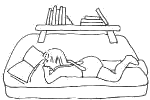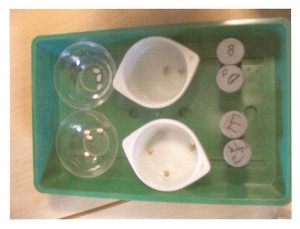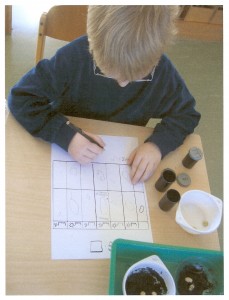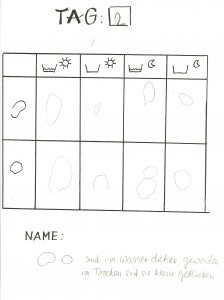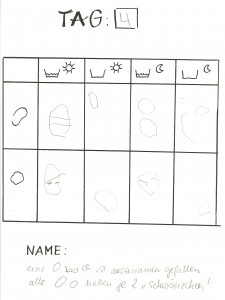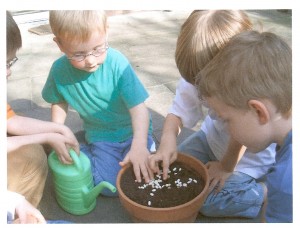by Klaudia Kruszynski
At the moment we are dealing with the theme of spring. This year we had to wait a particularly long time for it, winter just wouldn’t leave. In the middle of March, the time had finally come and we could hope for the returning life.
So we wanted to teach the children more about how plants develop. My aim was for the children to find out what factors influence the life of plants.
In a way, this project was also a continuation of the project: Time.
From observing the snowdrops growing in the outdoor area of the kindergarten, the children knew that some plants develop from a bulb that is hidden under the ground in winter. Now it was time to learn about the other kind of growth: the development of a plant from a seed.
… in a nutshell …
In this project, the children learn how to observe precisely and systematically over a longer period of time in order to come to new insights.
Little Sven (4;3) is particularly interested and can not only keep up with the older children, but is especially careful and persistent.
For this observation I chose beans and peas because they are quite large and robust compared to the other seeds. The children can see all the changes with the naked eye.
We started observing on a Monday at the end of March. It was in the afternoon, in my group there were 10 children aged 3 to 6, including Sven, Mark, Lukas,whom I wanted to involve particularly strongly in this project.
All the children sat down at the table, they were very excited about what was about to happen. I put two small bowls on the table: one with peas and the second with beans. I asked the children what it was.
I was surprised that they didn’t know raw beans, they thought they were „Tic-Tacs“. „If you don’t swallow them, then you get to taste if they are really the Tic-Tacs“.
To their horror, they realised that the „things“ were not sweets, they spat it all out.

Then I asked if they remembered what I was going to cook after work today. (I told them about this an hour earlier while painting, when the children reported what they had for lunch).
Aaron could remember: „bean soup“. Then I said that the elongated seeds are beans, and I didn’t cook those because I have something planned for them. And so most of the children saw uncooked beans for the first time. With the peas it was much easier, many children have already seen raw peas and eaten a pea stew.
All the children examined the seeds: the beans are white and smooth, the peas yellow-brown and „wrinkly“. Both types are firm and hard, you can’t bite them.
I put other small bowls and film jars on the table. Then I brought a small greenhouse from the storeroom. We still needed waterproof pens and water.
I explained to the children that we were going to do an experiment together:
„What will happen to the beans and peas over the next few days if we leave them in different environments?“
Everyone was motivated to participate, each child had something to do.
We took different bowls for the beans than for the peas, two of each kind. Sven poured a little water into one of them, the others stayed dry. Then the others put 2 or 3 seeds in each.
We did the same with the film jars and the big ones labelled the lids: B for beans and E for peas (in German: Erbsen). They also made a sign for water on one lid of each type.
I asked the children if they could imagine how the beans and peas were doing in the jars, what they „felt“?
At first the children looked at me in amazement, but because I remained serious, they got involved in the game.
Question: „What would one bean say to the other?“
Answer: „It’s wet“.
Question: „Can this bean see the other one?“
Answer: „No!“
Question: „Why?“
Answer: „Because it’s dark in the can!“
Question: „What is this bean missing?“
Answer: „Light!“
The children were very proud of their discovery.
In a moment they also knew what the peas were missing.
They also discovered that the beans and peas did not rustle in the jars that contained water. So you don’t have to take the lid off if you want to know if there is water in it.
The seeds in the small bowls have light. You can see them and don’t need a label.
Finally, we put all the containers inside the small greenhouse. We closed the ventilation flaps to keep it humid inside. We found a suitable spot on the windowsill where the box would be easy to observe.
The next day the children told the others what we had done the day before, they said that there are no Tic-Tacs in the shells, but peas and beans. No one is allowed to touch them, the greenhouse has to stay closed.
What was the best way to document
this experiment?
I decided to use photos and observation sheets because the children who took part could not yet write.
Some of the observation sheets were filled in by the children with great meticulousness. They had to observe carefully and think precisely and systematically.
I observed that Sven was particularly interested in this experiment. He is 4 years and 3 months old. He has a very good memory, quite a large vocabulary and shows a lot of activity in finding out different things. He is interested in what the „big ones“ do, chooses table games that are meant for older children. He also knows the exact rules of the game and makes sure that the children follow them.
On the other hand, he is very shy and hides his own feelings (for example, a disappointment because it is already too late for a game, or that he is sad because he lost a game). In such cases, he turns around very quickly and turns to a new activity. Surprisingly, he accepts any offer, whether it is a game or something to do or paint. When asked if he would like to do something, he seems to come out of an „idle“ or „waiting“ period. He quickly finishes the previous activity and waits for the promised offer. But he must know what it is all about – he does not get involved in surprises!
He has to understand with his head beforehand, which is not always necessary with the other children – they understand by doing. Then he is involved with his whole attention and can concentrate for a very long time – one has the impression that he would „lose himself“ in the activity and explore everything with his whole being. This is probably why he took part in the experiment.
I thought of some tasks that he could do every day in the process:
-
- Fetch the greenhouse from the windowsill for observation,
- Prepare the plate with the corresponding number for a stock photo,
- Take photographs,
- Fill in some observation sheets
or explain to the other children how to fill them in, - Return everything to the storage place.
Sven did his tasks very conscientiously. But when I asked other children to help, he wanted to run away and feigned disinterest.
The observation sheets have to be signed by the person completing them. Sven said he didn’t know how his name „goes“. The first time I guided his hand, but then I suggested that he could do it on his own. If he wanted, I could write his first name on a piece of paper for him to copy. He liked this suggestion very much, each time he took the piece of paper out of his pocket. He proudly showed it to his mother too: „This is how you write >Sven<„.
I noticed that he does not yet have a sense of direction when writing, the letters are turned on their side or upside down. This shows that he still has little interest in the technique of writing.
However, because he already showed a lot of interest in the letters, one afternoon I got him a set of foam rubber letters. Marius, who is 6 years old, picked out all the letters that form his first name from this set. Sven was overwhelmed by the set and tried in vain to find „his“ letters.
I helped him and together we put the word: SVEN on the table. Sven looked at it and asked if he could keep the letters. He couldn’t, but I could lend them to him. I put them into a small tin box and told him to bring them back when he had learned to put his name correctly or even to write it. Very proudly, he showed the tin to his mother when she came to pick him up.
Remember: Sven is aged only 4;3!
The other children, unlike Sven, only occasionally engaged with our experiment. They showed no interest in the systematic work. Only when visible changes occurred did they want to join in. But there were always „observers“ who preferred to watch what was happening from a distance while documenting.
Here are a few observation sheets from the 2nd, 4th and 8th day. On these days it was little Sven’s (4;3) turn to note down the observations.
Note: The beans and peas grew thicker in the water, but remained small when dry. The observation was interrupted after two weeks due to the Easter holidays.
Note: One bean with water and without light has fallen apart, all beans and peas have two „tails“ each.
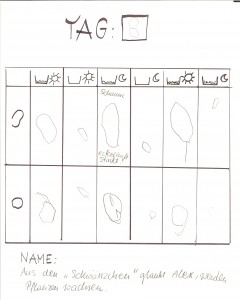
Note: Sven believes that plants grow from the „little tails“.
After the holidays we found our beans and peas dried out, mouldy or rotten. Contrary to the „prognoses“, no plants or roots developed from the „little tails“ (that’s what the children called the sprouts).
The children realised why:
Some kernels dried out because they didn’t get any water. The others had too much water.
The children didn’t know why the ones that had soil and light got mouldy. Maybe because there was no fresh air in the greenhouse, I said.
Everyone was very disappointed that we don’t get big plants.
Then I mentioned that I still have some beans and peas and we could maybe try again.
„How can we make it so we get big plants, what’s good for the seeds?“
„Soil.“ „Water.“ „Air.“
„And what else? What happened to the seeds that were in the cans?“
„They went bad and stunk!“
„Why? What was wrong with those beans and peas?“
The children gave different answers, but only Mark knew for sure: „Light!“
Then we filled a big flowerpot with soil. I opened the tin of peas and beans and the children spread them all over the surface.
I asked them if they knew how tall the plants would be. The children showed the height and width with their arms.
„Right“ – I said. „Do you think they will all have enough room in this pot?“
Wordlessly, they gathered up some beans and peas again and put them back in the tin.
Sven asked if he could fetch the water because the seeds needed it after all.
When he came back with the watering can, I asked if it was good to leave the seeds on top. Everyone said it was not good because they would be in the sun or the birds might eat them away. We decided to cover the seeds with soil. After that, Sven was finally allowed to water.
Every day the children took pictures of the pot.
The experiment is still going on. The weather is not so good yet, so it takes time for the plants to come.
But the children were curious and dug up some seeds. They noticed that the beans and peas had already become thicker, just like before, in the greenhouse. Then they carefully covered the seeds with the soil again.
A few days later, Marius brought two barley seeds that he found at his grandma’s house. He put them into the soil in our bean and pea pot. After 3 or 4 days, green sprouts had already developed, but the beans and peas had only become thicker.
I asked the children if they knew why the corn was already growing. Then Sven said that at the farmer’s the grain in the field is also green and already bigger.
„Why is the grain already so big and the beans and peas not yet?“
The answer was not easy to find, but Mark said that the grain does not take that long to grow. That’s right. And the beans and peas just take longer.
Then I told the children that some plants germinate very early, even when it’s still cold outside. It’s the same with cereals, that’s why many fields are already green.
„How does it look in the vegetable garden, are there already vegetables growing?“
„No, the beds are still black, there are only flowers in the garden“.
Then I said that many plants are waiting for the warmth. The beans and peas need a lot of warmth during the day, but they wait to grow until the nights get warmer too.
Just these days the children could see that there had been frost at night – the lawn was white in the morning.
Then we thought together about what the plants need to grow:
Water, light, air, soil and warmth.
It took a few more days before the children could observe a significant change in our pot. First, the seeds got „tails“ – I explained that they are properly called „sprouts“. Then the colour of the beans changed, they turned green. One bean split in two. I asked Sven if it would develop into a plant. At first he said yes, but when I reminded him of the experiment with the greenhouse, where the same thing had already happened, he said the bean would go bad and break.
The weather got better and the plants got bigger. The „little tails“ had become thicker and soon roots and stems grew from them. Thick leaves hung from the stems. Sven realised that they were halves of the bean. Later, the real leaves developed.
It took 25 days before we could see a significant change. The peas were still not ready, they needed even longer.
Sven made an effort to always give the plants enough water, sometimes the flower pot looked like an aquarium. That’s when I had to fall back on previous experience: „What happened to the seeds that had too much water?“
„They turned mouldy.“
„Do you think you need to water today?“
„Yes!“
„I think they have enough water.“
„No!“
„Please feel the earth, it’s damp.“
„No, it’s dry!“
And then I had an idea: „Get a Tempo handkerchief.“
But Sven didn’t understand why he should get a handkerchief, in a moment he came back without the handkerchief.
„Where’s the tissue?“
„In the bin, I’ve already blown my nose!“
One of the six-year-olds who had been watching what was happening brought a tissue.
Sven wanted to leave, but I called him back because I wanted to explain what I was going to do with the cloth.
He was to put it on the soil in the pot and press on it with a finger.
When he had done that, I asked what happened to the cloth. The other children shouted that it had got wet. Sven didn’t want to believe it, nor that the beans didn’t need water now.
The next day he did a cloth test himself, as well as in the other plant boxes that are on the terrace.
Other children also checked the soil moisture since then.
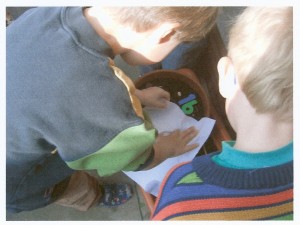 Contrary to my expectations, Lukas and Mark participated very little in this project. Lukas showed no interest in it, mostly keeping himself busy at the painting table. Mark only joined in when he had nothing to do. In discussions in the circle of chairs, he gave the right impulses – he knew what the plants needed and could report on previous changes.
Contrary to my expectations, Lukas and Mark participated very little in this project. Lukas showed no interest in it, mostly keeping himself busy at the painting table. Mark only joined in when he had nothing to do. In discussions in the circle of chairs, he gave the right impulses – he knew what the plants needed and could report on previous changes.
Mirko and Abdullah (both 6 years old) competed with Sven for the right to pick out the numbers, to water and to take photos. (Sven understood these tasks as his own).
I allowed this participation and was happy about it. All three were allowed to take turns and complement each other in the tasks.
This observation lasted several days. Every day a photo was taken to record the changes. Because nothing happened for a long time (in the biological sense), the task: „To put the next number for the photo“ took on a special meaning. We passed 10, then 20 and 30.
The children were challenged to find out the next bigger number every day. What was yesterday’s number, what is today’s, which one will come at the weekend?). At the same time, they had to put the number correctly (twenty-one as 21 and not 12).
Sven was just as good at this as his colleagues who were two years older.
My aim is for the children to discover one more factor. Plants do not only need: soil, sun, water, air and warmth for their development.
They also need time!
Different plants need different times to develop from a seed. I discovered that someone put a hazelnut in our experimental flower pot. I wonder if the children can guess how long it takes for it to grow into a hazel bush?
How long do the other plants in the garden take, how long do the trees in the forest take?
How long do people live?
How many „bean lives“ does human life take?
How many human lives does the „tree life“ last?
These are very interesting questions. I’m really curious to see what ideas they come up with. I’m especially interested in what Sven has to say about it. But also Mirko and Abdullah, who supported Sven in his „work“.
The subject of „time“ also needs time
so that the children can grasp it.
See also Klaudia Kruszynski’s article Playful Mathematics. In the section „Power“, children use the growth of beans to grasp the mathematical concept of (mathematical) power.
Observation sheet blanco (pdf)
Date of publication in German: April 2012
Copyright © Klaudia Kruszynski, see imprint.
